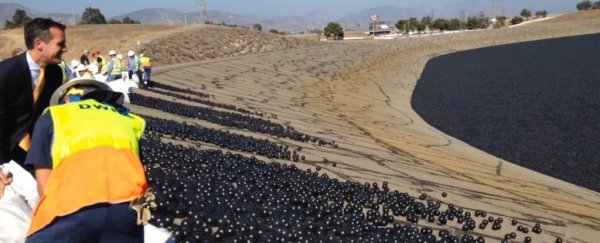In 2015, 96 million floating plastic 'shade' balls were dumped into the reservoir of drought-embattled Los Angeles. It was a plan to save water by preventing evaporation - and it did - but there was one big wet elephant in the room that was somehow overlooked.
Manufacturing that many plastic balls actually used more water than it saved.
According to calculations made by researchers from Imperial College London in the UK, MIT in the US and the University of Twente in the Netherlands, the oil, natural gas and electricity used in the manufacture of the plastic balls would have used around 2.9 million cubic metres of water.
The balls were deployed on the reservoir from August 2015 to March 2017. During that time, they prevented around 1.7 million cubic metres from evaporating.
Because the scheme saved water in one place by using more water elsewhere, it could have environmental impacts that weren't considered during the original planning phase. According to the researchers, this is a problem engineers sometimes fall prey to.
"We are very good at quick technological fixes, but we often overlook the long-term and secondary impacts of our solutions," said environmental scientist Kaveh Madani of Imperial College London.
"This is how the engineering community has been solving problems; solving one problem somewhere and creating a new problem elsewhere."
In order to 'break even' on water usage, the team predicted that the balls would have to be deployed for 2.5 years if they prevented evaporation at the same rate that occurred during the drought conditions.
And that's without considering effects on water temperature and bacterial growth and the impact that would have on the aquatic life that lives in the reservoir - concerns that were also raised in 2015.
So it's not quite the genius idea we - and many others - thought it was back in 2015, but that doesn't mean it's a total waste of time and resources, either.
The shade balls have a lifespan of 10 years (they were deployed for about 15 percent of that time), and are made of recyclable plastic, so they can go on to be reused for other purposes.
Shade balls have also been deployed in other reservoirs, most notably the Silver Lake Reservoirs in Los Angeles in 2008, to help prevent carcinogenic pollution.
They are also used by mining operations to prevent birds from landing on toxic tailing ponds, and by airports to deter birds from landing on drainage ponds, and risking collisions with planes.
And in the end, there's always something to be learned from such engineering experiments. Even a so-called 'failed' experiment is incredibly valuable for knowledge acquisition.
Research such as this shows that, even when solutions are implemented in a hurry, science can help us see and learn from our mistakes - and can help engineers to recognise and plan for such problems in the future.
"We are not suggesting that shade balls are bad and must not be used," Madani said. "We are just highlighting the fact that the environmental cost of shade balls must be considered together with their benefits."
The team's research has been published in the journal Nature Sustainability.
